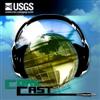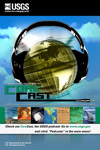USGS CoreCast
USGS Podcasts Home > CoreCast Home Page
Can't see Flash? Install Flash Player.
|
58
|

A roundup of the previous month's hazard-related events around the world, with some newsworthy tidbits.
Type: audio/mpeg
File Size: 4300596 bytes Duration: 4:24 Released: Thu, 7 Aug 2008 12:25:25 UTC |
Transcript:
Welcome and thanks for listening to the U.S. Geological Survey's Hazards Round-up for July 2008. I am Clarice Nassif Ransom, your host.
A magnitude-5.4 earthquake rocks southern California. Organizers of largest earthquake drill in U.S. history use science to plan earthquake preparedness. Two volcanoes erupt unexpectedly and explosively in Alaska.
These natural hazard issues kept USGS scientists busy in July 2008.
The magnitude 5.4 earthquake that rattled southern California on July 29 caused strong shaking, minor damage and was felt from Arizona to Nevada.
More than 120 aftershocks have been recorded. Most of them small. Many of them felt. The largest being a magnitude-3.8.
About 40,000 citizens recorded feeling the Southern California earthquake on the USGS Did You Feel It? web site.
For many southern Californians, this earthquake was a "wake-up" call. It's been more than 14 years since a notable earthquake caused significant damage in southern California. That was the magnitude-6.7 Northridge earthquake on Jan. 17, 1994.
And scientists say the next "big one" could be around the corner. California has more than a 99 percent chance of having a magnitude 6.7 or larger earthquake within the next 30 years.
You can listen to a podcast interview with USGS Scientist Dr. Mike Blanpeid about the Southern California earthquake at: http://www.usgs.gov/corecast/ Episode 56.
Be prepared for the big one...
Southern Californians are urged to join the largest earthquake drill in U.S. history on November 13, 2008.
The drill is based on a scientific report that portrays what could happen if a magnitude 7.8 earthquake strikes the southern end of the San Andreas Fault.
In the Scenario, the earthquake would kill 1800 people, injure 50,000, cause $213 billion in damage, and have long-lasting social and economic consequences. This is the most comprehensive analysis ever of what a major Southern California earthquake would mean.
The "ShakeOut Earthquake Scenario" was led by Dr. Lucy Jones, of the U.S. Geological Survey, and a group of over 300 experts.
Organizers of the shakeout drill are hoping to attract 5 million participants. For more information, log onto www.ShakeOut.org and pledge your family, school, business, or organization's participation in the drill. You will receive information on how to plan your drill, connect with other participants, and engage in earthquake preparedness.
In Volcano News ...
Okmok Volcano in Alaska erupted explosively and unexpectedly on July 12. Then, Cleveland Volcano, about 100 miles from Okmok, erupted July 21. Both eruptions produced ash plumes that caused airline flights to be diverted or cancelled.
Scientists faced a real challenge with Okmok's eruption. Okmok volcano went from being very quiet to a large eruption with almost no warning. The volcano area was too hazardous to enter in person and the ash plume blocked scientists from seeing what was happening inside the volcano.
So scientists had to use a combination of seismic and GPS instruments on the ground and weather and radar satellites in space to track the progress of Okmok's eruption.
Okmok and Cleveland's eruptions may continue for weeks. Scientists are providing around the clock monitoring of both Okmok and Cleveland volcanoes and will continue to issue timely information and coordinate with Federal and State agencies.
You can find out more information about the USGS Volcano Hazards Program at: http://volcanoes.usgs.gov/
Hazards Round up is a product of the US Geological Survey, Department of the Interior. Until next time, I'm Clarice Nassif Ransom.
Mentioned in this segment:
- USGS Earthquakes
- Okmok volcano
- Cleveland volcano
- Podcast: 5.4 Southern California Earthquake
- The Great ShakeOut
Music credit: Edgen, Battle at Norfolk


